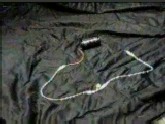Simple Circuitry
Simple Circuitry
Using alligator clips, 1.5 volt batteries, and small light bulbs,
the students are asked to create a simple circuit which is successful
if the light turns on. Thus they understand that electricity flows
in a loop. Then we ask them to break the circuit at some point
and reconnect it through some other material (for example leather,
skin, coins,
hair, watch) to complete the circuit. If the light turns on, we say
that the material is a good conductor. If the light does not come
on, then the material is a poor conductor, or an insulator. We also
point out that the battery is a source of direct current.

In general, metals make good conductors and non-metals make poor
conductors. Possibly mention the connection between good conductors
of electricity and good conductors of heat. This is easier to conceptualize.
Troubleshooting:
-Test the batteries and light bulbs before letting the students
experiment.
-Painted metal will not work.
-Wet materials are good conductors, so discourage the students from
trying their tongues, braces, etc.
- A very long strip of metal may not work in a circuit because
the resistance is too great (use smaller pieces of the material).
To Magnets And Magnetic Fields
To Main Page

